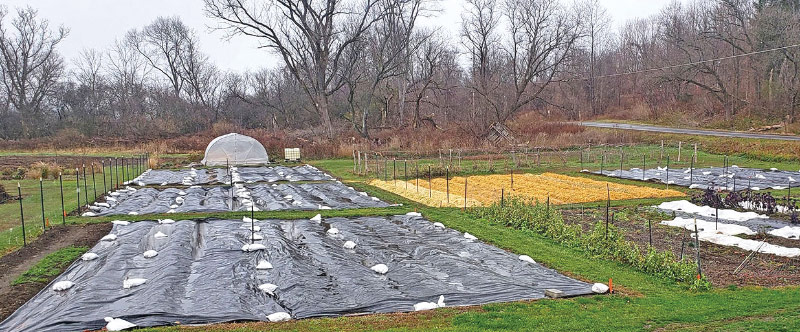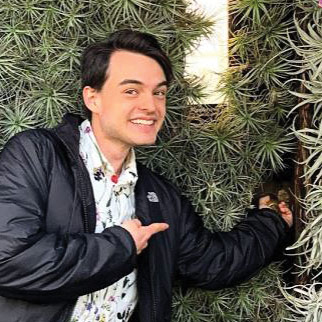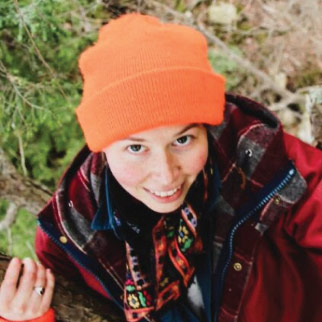Learn about Tarping on Northeast Farms with New Guide
By Stephen Stresow, Cornell Small Farms Program
A version of this article was first published on the Cornell Small Farms Program website at smallfarms.cornell.edu/2022/02/learn-about-tarping-on-northeast-farms-with-new-guide/.
Are you curious about how tarps work? Want to learn from successful practices as well as the challenges and shortcomings?
The Cornell Small Farms Program’s Reduced Tillage project is happy to share a new publication, “Tarping in the Northeast: A Guide for Small Farms” (extension.umaine.edu/publications/1075e/), that provides comprehensive information on the emerging practice of tarping—applying reusable tarps to the soil surface between crops and then removing them prior to planting—for weed and soil management. This guide is intended for both beginning and experienced farmers.
Tarping Guide Project Origins and Team
 |
|
Tarps being used to cover beds and being integrated into field planning at Centurion Farm (Locke, NY). Photo by Nina Saeli, Cornell Small Farms Program. |
The guide is a product of a working group on tarping and soil solarization funded by the Northeastern Integrated Pest Management (IPM) Center through the Partnership Grants Program. The project, led by Sonja Birthisel at the University of Maine, brought together institutions, educators, and farmers across the Northeast to connect the dots on what was happening with tarping in the region, share resources, identify knowledge gaps, and discuss future research directions.
The guide was a collaborative effort authored by Birthisel in conjunction with Natalie Lounsbury at the University of New Hampshire, Jason Lilley at UMaine Extension, and Ryan Maher, our reduced tillage project specialist.
Management Practices, Other Practical Applications
Based on research and farmer experience, the guide covers a range of management practices–including using tarps for weed seed depletion, minimal tillage, and cover-crop-based no-till—and uses case studies to highlight the methods used by farmers across the Northeast.
By combining the details of tarp logistics and management alongside the science of the practice, the guide is designed to support farmers in learning more about tarping and how to implement it to improve soil and weed management on their farms.
Co-author Maher has led tarping research experiments and worked with farmers to learn how they work and how to use them in reduced and no-till vegetable production.
“Tarps are a really multifunctional tool for small farms that help us get past some of the basic challenges using less tillage,” Maher said. “When we ask farmers how they work, we come up with a long list, then add a few jabs about the logistics. This guide puts all this practical information into one place, highlights successful farmers, and adds what we are learning through applied research, where we still have a long way to go to understand what’s happening under there.”
Further Information
The guide is hosted on the UMaine Extension website as a downloadable PDF at extension.umaine.edu/publications/1075e/.
The Northeastern IPM Center recently hosted a webinar about the guide presented by project director Birthisel. For more information about the webinar or to view the recording, visit neipmc.org/go/fxHS.
Links to the guide and other tarping resources are on the Cornell Small Farms Program’s Reduced Tillage project’s tarping webpage at smallfarms.cornell.edu/projects/reduced-tillage/tarping/.
About the Author
 |
|
Stephen Stresow. (Photo provided.) |
Stephen Stresow is a junior in the Cornell University College of Agriculture and Life Sciences studying plant sciences with a concentration in organic agriculture in addition to pursuing minors in soil science and crop management. He managed a vegetable garden as a Master Gardener in high school and has now scaled up that passion to sustainable vegetable production on small-scale farms. He is interested in improving agroecological practices and making them more accessible to farmers with the overarching goal of creating a more resilient food system. After a primarily virtual semester, Stephen is excited to get his hands dirty at the research farm this summer!
About the Researcher
 |
|
Sonja Birthisel. (Photo provided.) |
Sonja Birthisel, PhD, is a part-time faculty associate in the School of Forest Resources and Ecology and Environmental Sciences Program at the University of Maine.
The Northeastern IPM Center promotes integrated pest management for reducing risks to human health and the environment. If republishing our news, please acknowledge the source (“From Northeast IPM Insights”) along with a link to our website.
